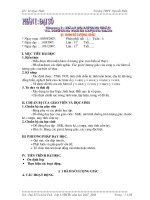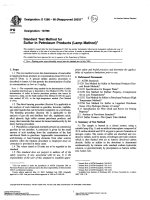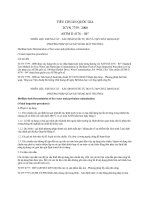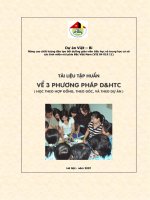Astm d 421 85 (2007)
Bạn đang xem bản rút gọn của tài liệu. Xem và tải ngay bản đầy đủ của tài liệu tại đây (53.39 KB, 2 trang )
Designation: D421 − 85 (Reapproved 2007)
Standard Practice for
Dry Preparation of Soil Samples for Particle-Size Analysis
and Determination of Soil Constants1
This standard is issued under the fixed designation D421; the number immediately following the designation indicates the year of
original adoption or, in the case of revision, the year of last revision. A number in parentheses indicates the year of last reapproval. A
superscript epsilon (´) indicates an editorial change since the last revision or reapproval.
This standard has been approved for use by agencies of the Department of Defense.
4.3 Sieves—A series of sieves, of square mesh woven wire
cloth, conforming to Specification E11. The sieves required are
as follows:
1. Scope
1.1 This practice covers the dry preparation of soil samples
as received from the field for particle-size analysis and the
determination of the soil constants.
1.2 This standard does not purport to address all of the
safety concerns, if any, associated with its use. It is the
responsibility of the user of this standard to establish appropriate safety and health practices and determine the applicability of regulatory limitations prior to use.
No. 4 (4.75-mm)
No. 10 (2.00-mm)
No. 40 (425-µm)
4.4 Sampler—A riffle sampler or sample splitter, for quartering the samples.
5. Sampling
5.1 Expose the soil sample as received from the field to the
air at room temperature until dried thoroughly. Break up the
aggregations thoroughly in the mortar with a rubber-covered
pestle. Select a representative sample of the amount required to
perform the desired tests by the method of quartering or by the
use of a sampler. The amounts of material required to perform
the individual tests are as follows:
5.1.1 Particle-Size Analysis—For the particle-size analysis,
material passing a No. 10 (2.00-mm) sieve is required in
amounts equal to 115 g of sandy soils and 65 g of either silt or
clay soils.
5.1.2 Tests for Soil Constants—For the tests for soil constants, material passing the No. 40 (425-µm) sieve is required
in total amount of 220 g, allocated as follows:
2. Referenced Documents
2.1 ASTM Standards:2
D2217 Practice for Wet Preparation of Soil Samples for
Particle-Size Analysis and Determination of Soil Constants
E11 Specification for Woven Wire Test Sieve Cloth and Test
Sieves
3. Significance and Use
3.1 This practice can be used to prepare samples for
particle-size and plasticity tests where it is desired to determine
test values on air-dried samples, or where it is known that air
drying does not have an effect on test results relative to samples
prepared in accordance with Practice D2217.
4. Apparatus
4.1 Balance, sensitive to 0.1 g.
4.2 Mortar and Rubber-Covered Pestle , suitable for breaking up the aggregations of soil particles.
Test
Grams
Liquid limit
Plastic limit
Centrifuge moisture equivalent
Volumetric shrinkage
Check tests
100
15
10
30
65
6. Preparation of Test Sample
6.1 Select that portion of the air-dried sample selected for
purpose of tests and record the mass as the mass of the total test
sample uncorrected for hygroscopic moisture. Separate the test
sample by sieving with a No. 10 (2.00-mm) sieve. Grind that
fraction retained on the No. 10 sieve in a mortar with a
rubber-covered pestle until the aggregations of soil particles
are broken up into the separate grains. Then separate the
ground soil into two fractions by sieving with a No. 10 sieve.
1
This practice is under the jurisdiction of ASTM Committee D18 on Soil and
Rock and is the direct responsibility of Subcommittee D18.03 on Texture, Plasticity
and Density Characteristics of Soils.
Current edition approved Sept. 1, 2007. Published September 2007. Originally
approved in 1935. Last previous edition approved in 2002 as D421 – 85 (2002).
DOI: 10.1520/D0421-85R07.
2
For referenced ASTM standards, visit the ASTM website, www.astm.org, or
contact ASTM Customer Service at For Annual Book of ASTM
Standards volume information, refer to the standard’s Document Summary page on
the ASTM website.
6.2 Wash that fraction retained after the second sieving free
of all fine material, dry, and weigh. Record this mass as the
Copyright © ASTM International, 100 Barr Harbor Drive, PO Box C700, West Conshohocken, PA 19428-2959. United States
1
D421 − 85 (2007)
mass of coarse material. Sieve the coarse material, after being
washed and dried, on the No. 4 (4.75-mm) sieve and record the
mass retained on the No. 4 sieve.
8. Test Sample for Soil Constants
8.1 Separate the remaining portion of the material passing
the No. 10 (2.00-mm) sieve into two parts by means of a No.
40 (425-µm) sieve. Discard the fraction retained on the No. 40
sieve. Use the fraction passing the No. 40 sieve for the
determination of the soil constants.
7. Test Sample for Particle-Size Analysis
7.1 Thoroughly mix together the fractions passing the No.
10 (2.00-mm) sieve in both sieving operations, and by the
method of quartering or the use of a sampler, select a portion
weighing approximately 115 g for sandy soils and approximately 65 g for silt and clay soil for particle-size analysis.
9. Keywords
9.1 dry preparation; particle-size analysis; soil
ASTM International takes no position respecting the validity of any patent rights asserted in connection with any item mentioned
in this standard. Users of this standard are expressly advised that determination of the validity of any such patent rights, and the risk
of infringement of such rights, are entirely their own responsibility.
This standard is subject to revision at any time by the responsible technical committee and must be reviewed every five years and
if not revised, either reapproved or withdrawn. Your comments are invited either for revision of this standard or for additional standards
and should be addressed to ASTM International Headquarters. Your comments will receive careful consideration at a meeting of the
responsible technical committee, which you may attend. If you feel that your comments have not received a fair hearing you should
make your views known to the ASTM Committee on Standards, at the address shown below.
This standard is copyrighted by ASTM International, 100 Barr Harbor Drive, PO Box C700, West Conshohocken, PA 19428-2959,
United States. Individual reprints (single or multiple copies) of this standard may be obtained by contacting ASTM at the above
address or at 610-832-9585 (phone), 610-832-9555 (fax), or (e-mail); or through the ASTM website
(www.astm.org). Permission rights to photocopy the standard may also be secured from the ASTM website (www.astm.org/
COPYRIGHT/).
2









